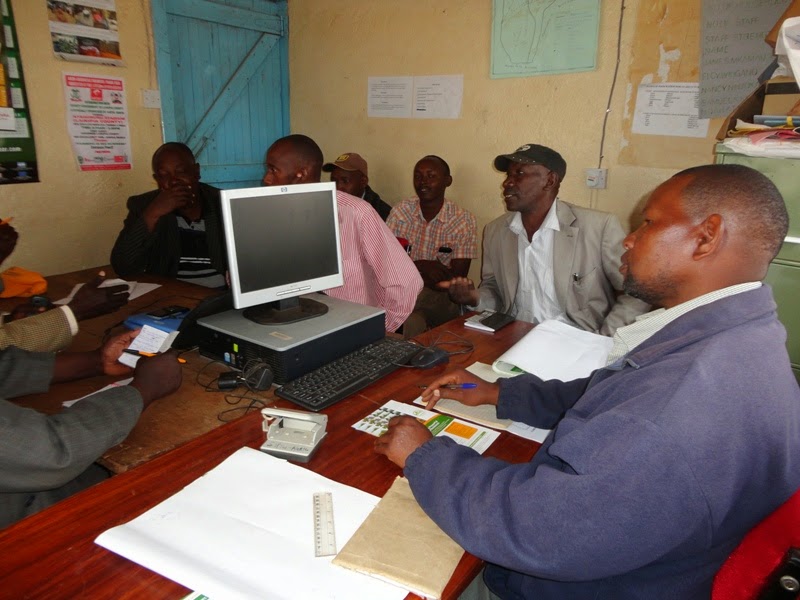By Robert Eyapan
Elcy Kigano, Divisional Crop Officer,
Ministry of Agriculture, Sipili division informed farmers that they will be
able to benefit from the demo plot as they will be trained on best farming
practices from tilling of land to post harvest grain handling.
Soil analysis had been conducted at
the farm by MEA Ltd. The analysis report indicated that the soil had become
acidic due to continuous use of DAP. The farmers used NPK 23:23:0 in the demo
plot.
When hand-planting, put fertilizer in
the hole, stir with a panga to mix the fertilizer with the soil, then put the
seed. Cover the seed with loose soil.
Arid Lands Information Network (ALIN)
together with the Ministry of Agriculture, Livestock and Fisheries, MEA Ltd and
Kenya Seed Company Ltd on April 28, 2014 established a demonstration plot at
Mlima Meza area of Kabati in Laikipia County. The demo plot which has been
established at Tabitha Wanjiru’s farm will act as a place where farmers will be
taught best farming practices.
 |
| Elcy explaining the correct planting procedure |
“This is just the beginning as you
will be trained during the entire process of farming. You can only practice
Kilimo Biashara if you increase your production,” said Elcy.
Bob Aston from Ng’arua Maarifa Centre
said that Arid Lands Information Network (ALIN) has been promoting sustainable
family farming by stressing its capacity to address hunger, poverty,
environmental degradation and climate change.
Bob said they are now trying to
ensure that farmers automate their records through Farm Record Management
Information System – Kenya (FARMIS Kenya).
“Proper record keeping is important
as it will help you to know whether you are making a profit or loss. When you
keep your records well it will be easier to monitor your farming activities.
This will be possible through FARMIS Kenya,” said Bob.
Certified hybrid seeds from Kenya
Seed Company Ltd were planted in the demo plot. The varieties that have been
planted are; H520, H624, H629, H626, and H6210.
The five certified hybrid seeds have
different characteristics like; H624 is tolerant to grey leaf spot, leaf blight and
rust. H6210 has good husk cover and is tolerant to lodging and leaf blight. H629
produce big maize, has good
husk cover and is leaf blight tolerant. H626 is tolerant to lodging and most leaf diseases. H520 matures early, is tolerant to leaf rust, lodging and grey leaf spot. H624 is tolerant to grey leaf spot, leaf blight and rust.
 |
| Elcy explaining how to mix soil with fertilizer |
Elcy said that NPK fertilizer
contains nitrogen, phosphorous and potassium. Nitrogen functions as a means for
the plant to produce more chlorophyll. This helps plant foliage to grow strong
and allow for a dark green color. Phosphorus aids in the initial growth of plants
by contributing to root development.
She said that nitrogen fertilizers
are very soluble and move readily in moist soil thus placement with or very
near the seed is not necessary to ensure effective utilization. Phosphate fertilizers
do not move readily in soil thus placing the band of phosphate near developing
seedling roots is most effective while Potassium will
move in the soil more readily than phosphorus.
“When planting ensure seeds are not
planted directly in contact with fertilizer as this can cause poor germination
due to scorching,” said Elcy.
Elcy said that Sipili is a marginal
area hence spacing is supposed to be 90 cm by 30 cm. From one line to the next
line is supposed to measure 90 cm while from one hole to the next hole is
supposed to be 30 cm.
“High yields can only be obtained if
the correct number of plants are grown. You are also supposed to ensure there
is good management during physiological maturity,” said Elcy.
She advised farmers to practice pure
stand as mixing maize and beans together normally leads to reduced yields.
Hole dug for the seedlings should be
8 cm deep when planting when the ground is dry while it should be 5 cm deep
when planting when the ground is wet or rather during the rainy season. This
will help to prevent losses of the seeds from insect pests and ground
squirrels.
 |
| Community members planting at the demonstration farm |
Elcy advised farmers to always plant
early at the beginning of the long rains as yields are greatly reduced by late
planting,
“This season it has not rained here
in Sipili hence most farmers have not planted while some who had already planted
are experiencing a lot of problem their crops have not geminated or have wilted,”
said Elcy.
She said that land choked with grass and
other weeds will not produce good maize crops while not using certified hybrid
seeds and correct fertilizer will lead to low yield.
Similar demonstration plots have also
been established at Kahuruko area in Jackson Chege’s farm, Makutano B area at Peter
Mwaniki’s farm, Muhotetu at Waweru Kanja’s farm and Naiborom at Charles Nderitu’s
farm.




















